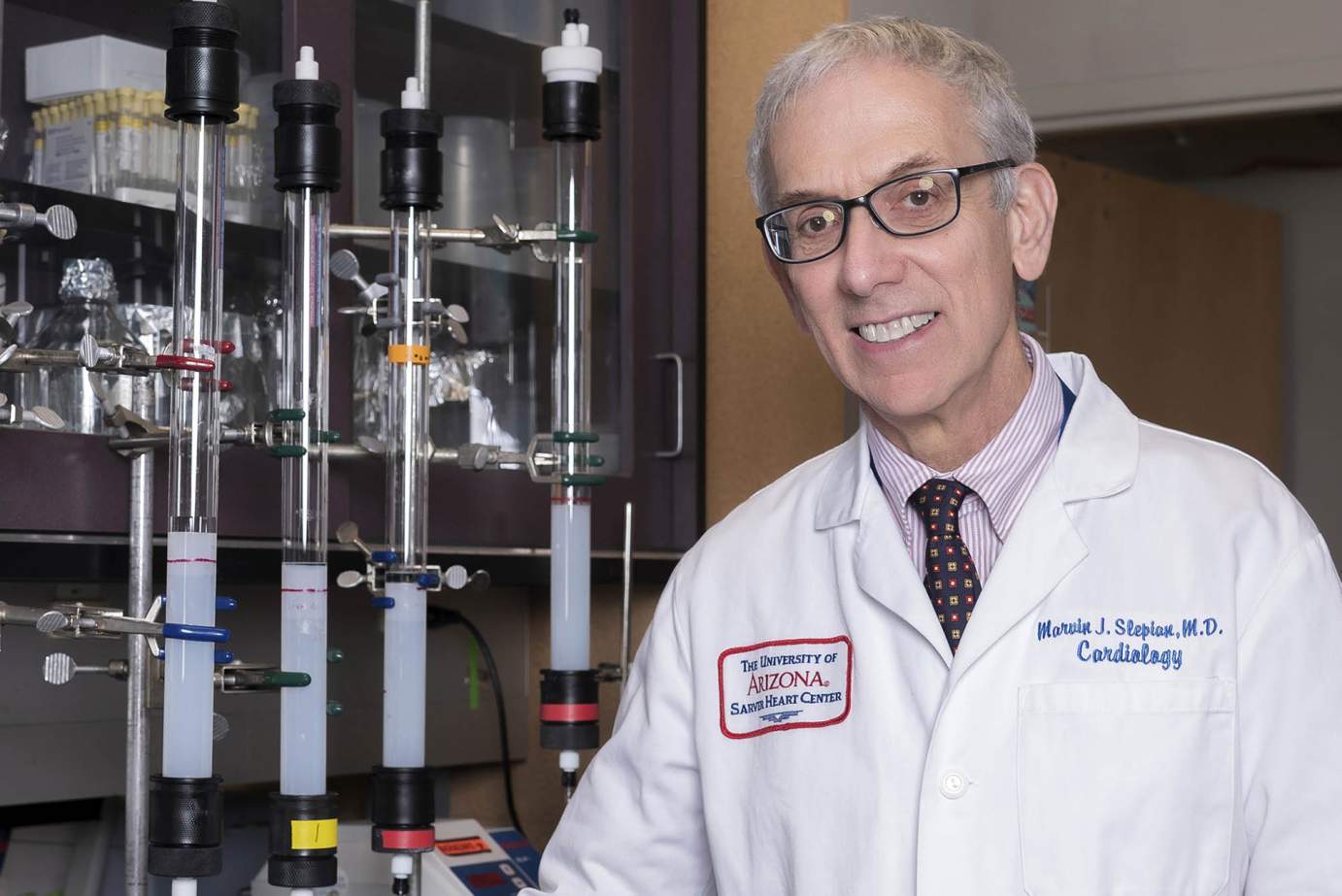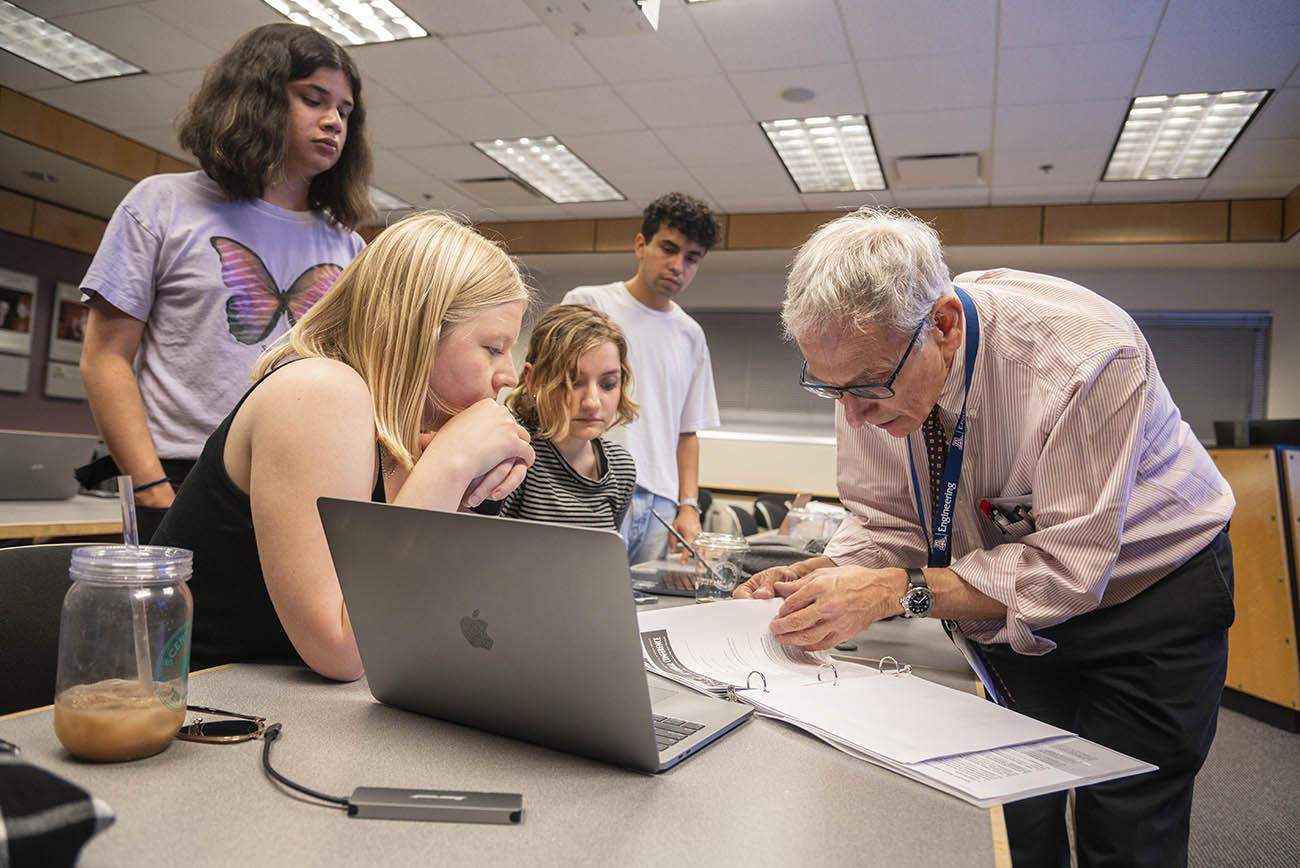Regents Professor Marvin Slepian, MD, JD, is a renaissance man whose curiosity as a child has only continued to grow, leading him to hundreds of patents and a lifetime of mentorship.
Inducted into the National Academy of Inventors in 2019, Marvin Slepian, MD, JD, is a named inventor on over 160 issued or pending patents.
A Regents Professor of Medicine and Medical Imaging in the University of Arizona College of Medicine – Tucson and Biomedical Engineering at the UArizona College of Engineering, Dr. Slepian co-founded SynCardia Systems, which makes the only FDA-approved total artificial heart, and has founded several other medical device companies. He’s brought revolutionary ideas to medicine, such as stents that release drugs and a “paving” material to repair and treat arteries and other tissues, and has taught innovation, literally, for the past decade.
The secret to his success? There isn’t one. That is, there isn’t just one.
Addressing unmet needs
 While there are a number of ways that Dr. Slepian, who also holds professorships in materials science and engineering and chemical and environmental engineering, approaches invention and several tenets that inform his teaching, the point where they all converge is in addressing unmet needs.
While there are a number of ways that Dr. Slepian, who also holds professorships in materials science and engineering and chemical and environmental engineering, approaches invention and several tenets that inform his teaching, the point where they all converge is in addressing unmet needs.
In the early 1980s, fresh out of medical school and a young intern at Bellevue, the teaching hospital of New York University, Dr. Slepian witnessed first-hand the growing epidemic of heart disorders. The magnitude of the problem and the unmet need for care drove Dr. Slepian onto a path that shaped his life for decades to come.
“My whole background was in microbiology and biochemistry, which would lend itself to working on infectious disease or cancer medicine or rheumatology,” said Dr. Slepian, who is also a member of both the Sarver Heart Center and BIO5 Institute. “Cardiology is tubes, pipes and pressures – more engineering. But I saw this gap, so I said, ‘What, if I take everything I know on the molecular side and put it into cardiology?’”
That decision took his work and education down new paths, exploring platelet clotting, inflammation and cell regrowth – complications that within just a few years would limit the effectiveness of interventions like angioplasty and stents. They were complications that his pioneering work and commitment to unmet needs would ultimately help overcome.
Curiosity and exposure
“I was always a curious kid, looking at pond water under the microscope, building things at an early age, mixing chemicals and examining their effects on plants and cells,” Dr. Slepian recalls. But successful innovation takes more than just a curious mind, he says. It thrives on exposure.
Dr. Slepian’s parents encouraged his curiosity from the start. His mother was a high school principal, and his father taught medicine and had a lab in their home. He went to Stuyvesant High School, one of New York City’s “specialized” public college prep high schools with a heavy focus on science. He won science fairs and as a freshman in college was selected to be the U.S. student representative for that year’s Nobel Prize ceremonies.
 “The key thing about all that exposure was seeing, ‘Wow – you can really do things that make a difference!’” he said. But doing that also means being tuned into the world around you, another important dimension of “exposure.”
“The key thing about all that exposure was seeing, ‘Wow – you can really do things that make a difference!’” he said. But doing that also means being tuned into the world around you, another important dimension of “exposure.”
While a freshman in high school, Dr. Slepian began to experiment with viral systems and by his senior year had developed five methods for creating polymer-based synthetic viruses that were capable of packaging exogenous DNA by encapsulating it within protein structures.
Yes, Dr. Slepian developed a novel drug-delivery system that essentially hijacked the infection vectors of engineered, large-molecule viruses in high school.
Not surprisingly, he swept awards on the science fair circuit, even competing internationally. His work won awards from the Army, Navy, Air Force and Atomic Energy Commission. And he credits that success, in part, to his mentor, Abraham Baumel, a chemistry and physics teacher and City College professor who would go on to become Stuyvesant’s principal.
Critical mentorship
Dr. Slepian chose to attend Princeton University for its program in science and human affairs. As an undergrad, he became a radio announcer for WPRB, fascinated by the flow of information from the pre-internet teletype news feed. He worked with the Robert Wood Johnson Foundation, to study the impact of social work on health care and sought friends who were studying in the humanities.
“You can't just be a narrowly focused science or technical person,” he said. “You have to be sensitive to society, people and the world around you. Interdisciplinary work is the buzzword today, but it’s absolutely critical you take some humanities, you understand some math and computing, gain exposure to arts and letters and civics. It’s all important.”
Mentorship would play a key role in Dr. Slepian’s education and professional development, and he returns the favor now by mentoring more than 100 undergraduate and graduate students a year – some through his Innovation, Translation & Entrepreneurship course, some through students taking electives and some through an initiative he created for team-based engineering and design.
“I’m very passionate about students getting their hands wet and doing things you can actually see,” Dr. Slepian says. “I’ve always had great teachers who gave me great insights. It’s all about mentorship. You need to excite, inspire, guide and propel others. That’s something I might want on my tombstone.”
Multiple perspectives
His lab work continued throughout medical school, and a five-month stint at the National Institutes of Health gave him a much broader understanding of health and medicine, including basic knowledge of cancer, arthritis, metabolism, allergy and infectious diseases. His focus on immunology while there led him to explore connections between inflammation, the immune system and platelet function.
It was the layering of all those experiences that led him to invent endoluminal paving as an alternative to the contemporary technology of stents made of steel. Dr. Slepian patented a biodegradable polymer material that lines the inner walls of arteries, simultaneously providing structural support, a therapeutic barrier and a pathway for drug delivery.
“I took this work from 15 years prior and reapplied it in a cardiovascular domain,” he says. “I tell this to students: You have to understand different things. You absolutely have to be really good at a few things, but you also need familiarity with multiple fields to be able to then pull from them and integrate. That’s key.”
Incremental learning
On a sunny Saturday in May, Marvin Slepian graduated from the UArizona James E. Rogers College of Law, adding “JD” to the “MD” that has followed his name since 1981.
He’d been interested in law at an early age and repeatedly found himself unpacking legal issues as a physician-scientist inventor and entrepreneur. For him, law school was a natural extension of lifelong learning: residency at NYU School of Medicine, research and clinical fellowships at Johns Hopkins University and the Cleveland Clinic, post-doctoral training in polymer chemistry and chemical engineering at Massachusetts Institute of Technology and business and management training at Harvard Business School.
“As you evolve, as your career progresses, you’re going to need more information. But the point is, there’s never an easy way to get it all at once. Most people can’t just stop their careers and go back to school. But you add something here and you add something there, and over time, it all adds up.”
“You're never going to be an expert in everything,” Dr. Slepian says, “but you need to get in the water and swim around.”
Next-generation innovation
Marvin Slepian, MD, JD, is a truly a “triple threat” in his field: clinician, researcher and professor. When not seeing patients or advancing studies, he’s nurturing generations of future researchers to continue his legacy of impact in the gaps where it’s needed most.
For over a decade, he’s taught a course he created for the UArizona Eller College of Management: Innovation, Translation & Entrepreneurship.
Mixing graduate and undergraduate students from many disciplines, the course explores drivers of innovation and the many dimensions of invention, new ventures and long-term vision – not in vague, high-level theory but in hands-on, rubber-meets-the-road application.
Students learn how to identify opportunities, dissect and break down problems, assemble necessary expertise for solutions and make hard choices around the real constraints of feasibility, resources, intellectual property, market forces, regulatory issues and potential impact.
In 2012, in response to a limited-submission call for proposals from the National Institutes of Health, Dr. Slepian envisioned and laid the initial planning for what became the university's Arizona Center for Accelerated Biomedical Innovation, where he serves as director.
Consistent with how Dr. Slepian engages the world, the center was created to fill a gap he identified in the innovation infrastructure. “You’ve got bright people doing great research,” he explains. “They’ve got the brainpower, but not necessarily the innovation mindset or training. And then you have a great tech transfer group like Tech Launch Arizona, but they don’t do the inventing.”
ACABI works as a missing link, identifying problems and bringing together brilliant minds to “churn” those problems against an inventory of extant science, including UArizona developed IP. Not surprisingly, its mission maintains and updates a list of 100 unmet medical needs as well as the science and technologies to potentially address them. With a track record of significant outcomes, university leadership is now working with Dr. Slepian to expand the ACABI model to drive innovation in fields beyond healthcare.
Through ACABI, Dr. Slepian also created an annual collective of a few dozen students from biomedical engineering, data science, physiology and medicine. They work on small-team projects while also bringing their diverse knowledge to bear on one full-group project, often focused on telehealth and the intersection of medicine and digital technologies. Their work regularly wins awards and earns top honors at conferences across the country.
“It’s an exciting time for students and the university,” Dr. Slepian said. “We need professors and students working beyond traditional departments. We need people not just thinking outside the box but doing things outside the box, handling things, working on real problems. This is where we need education to go.”
ALSO SEE:
"Would you trust an AI doctor? New research shows patients are split" | Posted May 19, 2023


